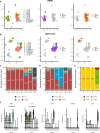Development of ferret immune repertoire reference resources and single-cell-based high-throughput profiling assays
- PMID: 40116504
- PMCID: PMC11998538
- DOI: 10.1128/jvi.00181-25
Development of ferret immune repertoire reference resources and single-cell-based high-throughput profiling assays
Abstract
Domestic ferrets (Mustela putorius furo) are important for modeling human respiratory diseases. However, ferret B and T cell receptors have not been completely identified or annotated, limiting immune repertoire studies. Here, we performed long-read transcriptome sequencing of ferret splenocyte and lymph node samples to obtain over 120,000 high-quality full-length immunoglobin (Ig) and T cell receptor (TCR) transcripts. We constructed a complete reference set of the constant regions of ferret Ig and TCR isotypes and chain types. We also systematically annotated germline Ig and TCR variable (V), diversity (D), joining (J), and constant (C) genes on a recent ferret reference genome assembly. We designed new ferret-specific immune repertoire profiling assays by targeting positions in constant regions without allelic diversity across 11 ferret genome assemblies and experimentally validated them using a commercially compatible single-cell-based platform. These improved resources and assays will enable future studies to fully capture ferret immune repertoire diversity.IMPORTANCEDomestic ferrets (Mustela putorius furo) are an increasingly common model organism to study human respiratory diseases such as influenza infections. However, researchers lack ferret-specific reagents and resources to study the immune system and immune response in ferrets. In this study, we developed comprehensive ferret immune repertoire reference resources and assays, which will enable more accurate analyses of the ferret immune system in the future.
Keywords: VDJ annotation; ferret; immune repertoire; reference resource development; repertoire profiling; single-cell sequencing.
Conflict of interest statement
X.P. is the Founder and CEO of and has an equity interest in Depict Bio, LLC. The terms of this arrangement have been reviewed and approved by NC State University in accordance with its policy on objectivity in research.
Figures




Similar articles
-
Systematic Profiling of Full-Length Ig and TCR Repertoire Diversity in Rhesus Macaque through Long Read Transcriptome Sequencing.J Immunol. 2020 Jun 15;204(12):3434-3444. doi: 10.4049/jimmunol.1901256. Epub 2020 May 6. J Immunol. 2020. PMID: 32376650 Free PMC article.
-
Sequencing B cell receptors from ferrets (Mustela putorius furo).PLoS One. 2020 May 29;15(5):e0233794. doi: 10.1371/journal.pone.0233794. eCollection 2020. PLoS One. 2020. PMID: 32470013 Free PMC article.
-
Characterization of the ferret TRB locus guided by V, D, J, and C gene expression analysis.Immunogenetics. 2020 Feb;72(1-2):101-108. doi: 10.1007/s00251-019-01142-9. Epub 2019 Dec 3. Immunogenetics. 2020. PMID: 31797007 Free PMC article. Review.
-
The draft genome sequence of the ferret (Mustela putorius furo) facilitates study of human respiratory disease.Nat Biotechnol. 2014 Dec;32(12):1250-5. doi: 10.1038/nbt.3079. Epub 2014 Nov 17. Nat Biotechnol. 2014. PMID: 25402615 Free PMC article.
-
The Ferret as a Model for Filovirus Pathogenesis and Countermeasure Evaluation.ILAR J. 2022 Jan 7;61(1):62-71. doi: 10.1093/ilar/ilab011. ILAR J. 2022. PMID: 33951727 Review.
References
-
- Bodewes R, Kreijtz JHCM, Geelhoed-Mieras MM, van Amerongen G, Verburgh RJ, van Trierum SE, Kuiken T, Fouchier RAM, Osterhaus ADME, Rimmelzwaan GF. 2011. Vaccination against seasonal influenza A/H3N2 virus reduces the induction of heterosubtypic immunity against influenza A/H5N1 virus infection in ferrets. J Virol 85:2695–2702. doi:10.1128/JVI.02371-10 - DOI - PMC - PubMed
MeSH terms
Substances
Grants and funding
LinkOut - more resources
Full Text Sources

